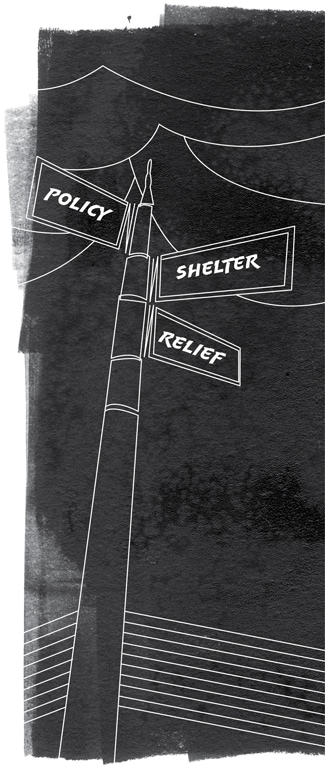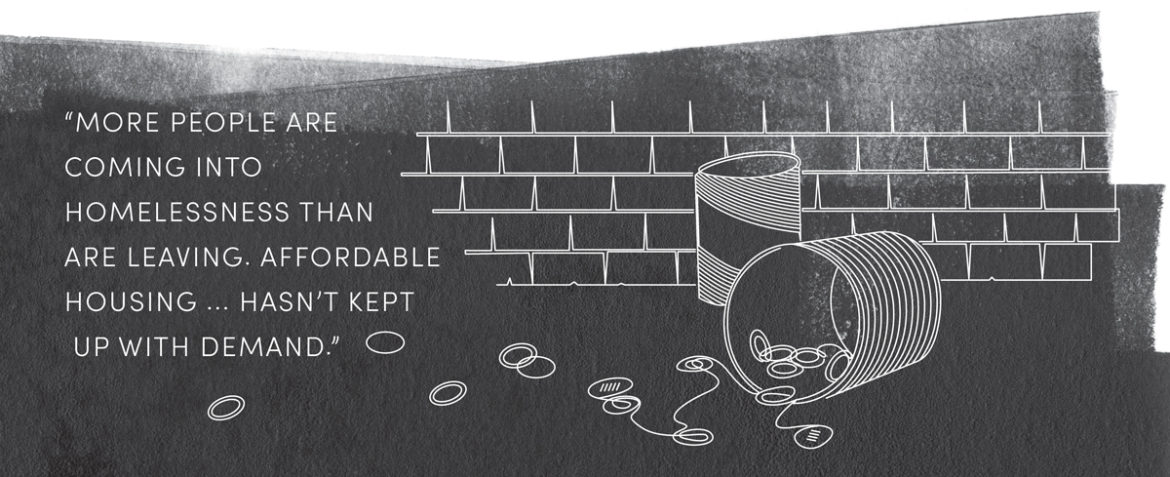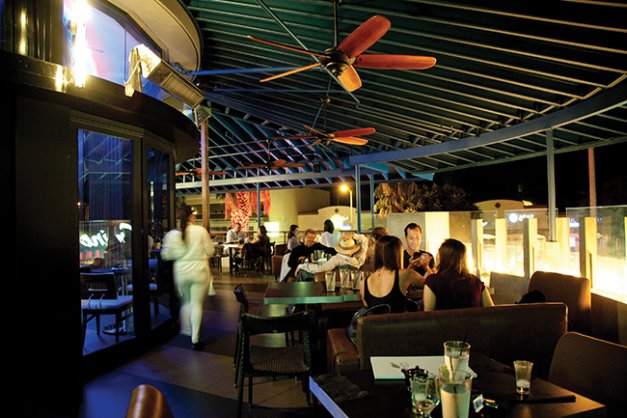
An In-depth Look at the Uptick in the Valley’s Homeless Population
The numbers tell the story.
It is a Wednesday night and the cafeteria at Notre Dame High School is packed—with adults. It’s the monthly meeting of the powerful Sherman Oaks Homeowners Association (SOHA), well known at City Hall for its ability to influence voters and change policies. The regulars are all there: lawyers, realtors, business owners, housewives, actors, retirees, all awaiting the evening’s speakers. Many of these mostly white middle-agers and senior citizens grew up in the San Fernando Valley and have never left. They love where they live. But on this night, the mood was one of frustration. On the agenda: the Valley’s homeless population.
“Oh my gosh, yes. I’ve never seen it like this,” remarked the elegantly attired Shirley Rastatter. She’s 91 and has lived in the Valley since 1960. She bought her nearby home for less than what you’d pay for a new Prius, and has watched her neighborhood deteriorate with homeless encampments. “This is just shocking … I think we’re in big trouble.”
Judy Chee, an HR executive, concurs. “I’ve been chased by homeless people. I’ve had stuff thrown at me. I don’t feel safe walking on my street or on Ventura Boulevard if homeless people are there.”
Amid their fear about their own safety, there is also genuine concern. For years SOHA has tried to support the homeless; members voted yes, along with the rest of the city and county, to increased taxes to cover housing and services. But now some residents have mixed feelings. “At what point does compassion threaten my safety or my family’s safety? We’ve passed these measures. Where are the improvements? Where are the changes?” Bob Reith, a college administrator, says. “The only changes seem to be an increase in homeless people. That’s what tugs at you. You feel for these people, but at the same time you’re afraid.”
MANAGING THE CRISIS
The questions on everyone’s mind: What is causing the increased homeless population and what can we do about it? There are no simple answers. Experts at organizations like the Los Angeles Housing Services Authority (LAHSA) will tell you it’s a “complex” issue. LAHSA was created in 1993 to coordinate homeless relief efforts and distribute money. LAHSA Commissioner Wendy Greuel, appointed by Mayor Garcetti says, “More people are coming into homelessness than are leaving. Affordable housing is a huge part of it. It just hasn’t kept up with demand.” Greuel, a Valley resident, a former LA councilwoman and controller who attended the Homeowners Association meeting, said she shared the frustration. “It’s a crisis.”
Another attendee, the oft-quoted academic Gary Blasi of UCLA asked, “How do we manage it in a way that gets people in a better place than they are now? I’m not convinced that the system is operating at a level necessary to keep up with the needs of people. It’s not operating at a level of efficiency that it could be.” That opinion was strongly backed by an August audit released by LA City Controller Ron Galperin that said, in essence, LAHSA has fallen way short of meeting its goals.

IMPLEMENTING SOLUTIONS
The long-term approach to solving the crisis is clear: Build more subsidized housing, provide services nearby, and do outreach to get homeless people to move in. Along those lines, there is some progress. LA city voters passed Measure HHH three years ago—essentially a loan program to help fund new construction. The first building is expected to open by the end of the year, and there are reportedly some 150 projects in the pipeline. LA County voters then approved Measure H as a companion plan to fund the services that go along with moving the homeless into housing.
Mayor Garcetti has installed a Unified Homelessness Response Center in a downtown building—complete with a compelling graphics package (“Confronting the Crisis”)—and there are regular meetings, with reporters invited, to update plans and achievements. Garcetti, who insists that this is his top priority, is also aggressively pursuing a proposal to have at least one “bridge home,” i.e., temporary shelter, in every council district. A few have opened around the city, but they have a relatively small number of beds. In the Valley, a women’s shelter in Sylmar is currently under construction. Four other bridge shelters are apparently in the planning stages.
In the meantime, the city and LAHSA have increased the number of social workers in street teams that engage with the homeless, and there are more Department of Street Services cleanup teams focusing on encampments—even hiring some homeless to help do the work. Residents can call 311 to report a city problem and be routed to the proper department for help. If it’s an encampment issue, for example, callers are routed to Sanitation. If it is a problem with a specific homeless person, you can call 211 and request that LA County’s Homeless Outreach Mobile Engagement unit send someone out to check. But don’t expect a commitment on timing.
Residents who really want to take a deep dive into the matter can connect to lahsa.org and explore LA-HOP, the site’s Homeless Outreach Portal, to learn about services, laws, referrals and reporting protocols.
Beyond local efforts, Governor Gavin Newsom created a Homeless and Supportive Housing Advisory Task Force in May. Sacramento Mayor Darrell Steinberg and LA County Supervisor Mark Ridley-Thomas serve as its chairmen. It’s not clear what, if anything, they’ve done so far. Governor Newsom has talked of declaring an emergency, though as of this writing he has not. President Trump, during a September visit to LA, made a lot of provocative comments about the problems that made headlines, followed by a visit by Ben Carson, secretary of Housing and Urban Development. Neither offered specific solutions.
GETTING ASSISTANCE
So what do you do when you feel endangered—when you’re afraid of a homeless person, who, for example, is exhibiting signs of mental instability or drug use? You can call the police, but note that being homeless or acting strangely is not a crime. “What we can’t do is rub the lamp and make the homeless go away,” is the blunt assessment of LAPD Commander Don Graham. He was appointed to the newly created job of LAPD homeless coordinator in the fall. He’s worked and lived in the Valley most of his life. At the SOHA meeting, he patiently explained to the crowd that law enforcement officers are constrained by laws and lawsuit settlements that limit what they can do. If someone decides to pitch a tent on the sidewalk in front of your home, it is legal, as long as there is 36 inches of space allowed for others to pass. “This is the social problem of our time,” Graham concluded.
If a homeless person is exhibiting disconcerting behavior (i.e., talking to themselves, shouting, walking or dancing in the street), you can call 911 and wait for a police response, or you can 211 and request assistance. But if that person is not an immediate and clear danger to themselves or others, they can’t be taken in against their will. However, Graham was quick to say, “If you see a crime, I will handle it. If there’s a narcotics issue around a homeless encampment, we will recommit to that problem.” The question is: What constitutes a crime, and is one really occurring? Another police officer at the SOHA meeting that night, who didn’t want to talk for attribution, shared that due to overcrowding and changes in laws that have turned felonies into misdemeanors, offenders are often back on the street within hours.
THE PERSONAL STORIES
So who are the homeless and how did they get there? For many, it’s the high cost of living in a tight housing market where rental costs have soared. Even a small increase can push employed, but low-income, people into homelessness. Some have lost jobs and are without a safety net. Others are mentally ill or struggling with drug addiction. Often they find a sense of community in the encampments that have popped up all over the Valley.
At the Studio City farmer’s market one Sunday, I met 74-year-old Kristina. As with most homeless people I’ve interviewed, it was hard to get a complete grasp on her story. “I’m not a street person. I can’t live on the street,” she insisted. She claims she can’t live in a shelter because of allergies. “I get more sick than if I’m on the street,” she explained. Apart from the handmade cardboard sign Kristina was holding, “Homeless Please Help Thank You,” she looked like a typical grandmother, albeit one with an especially weathered face. She couldn’t or wouldn’t say exactly how long she’s been living on the streets, but shared that she gets $600 a month from Social Security. She was widowed young, had a series of jobs including cleaning lady and babysitter, but no real savings or stable family. “I had an apartment and I lost it. I’m single now. I have my daughter and my grandson. … When we first lost the apartment, we got by with friends, until they couldn’t have us anymore. Then we slept in the car, which is horrible. Now I try to find the cheapest motel in the area, but when I can’t afford that, we sleep in the car or on the street.”
I also met 55-year-old Art, who said he’s been living in a tent under a freeway overpass for six years. He lives off a $900 monthly disability check. “The quality of life is much better here than in a shelter,” he remarked. Art says he would love to get a job, but “the mental health department said I’m disabled and unemployable.”
HELPING HANDS
As officials work to come up with a solution, others are taking matters into their own hands. Reverend Stephanie Jaeger of St. Matthews Lutheran Church in North Hollywood helps the homeless with a pop-up Homeless Access Center she founded at the church. She is also a member of the newly created Homeless Committee on the NOHO Neighborhood Council. She is optimistic that things will get better. “I understand the frustration, but we have the tools and strategy to make it work. It’s a slow rollout, but it will succeed. While we wait for housing to be built, for temporary shelters to go up, there are ways for every neighbor to volunteer, to donate time or clothing or help caseworkers. It makes a huge difference,” she says. Staffed by volunteers, the church’s homeless center has helped dozens get off the streets, after connecting them with services, doctors and therapists, according to Jaeger. She believes the key in getting people off the streets is trust. “When people trust you they will take services. They won’t if someone just walks up to them on an off-ramp.”
Homeless by the Numbers
58,936 | Number of homeless in LA County in 2019
$47.50 | Hourly wage that residents must make to afford the median LA rent*
12% | Increase of homeless in LA County 2018–19
30% | Increase in number of homeless in LA County 2015–19
7,730 | Number of homeless in San Fernando and Santa Clarita Valleys
851 | Number of LAHSA outreach workers
21,631 | Number of people LAHSA housed in 2018
34% | Increase in number of people LAHSA housed between 2018 and 2019
*from LAHSA as reported in The New York Times












